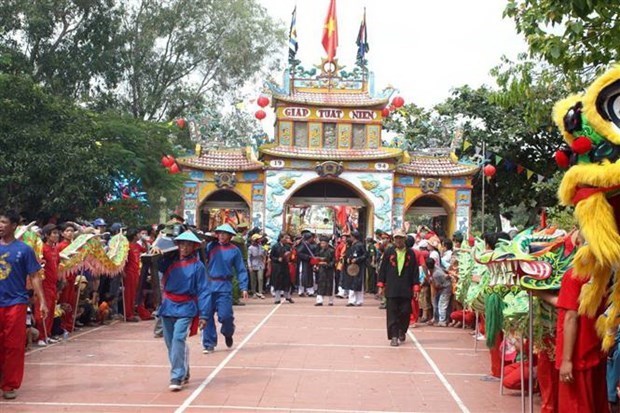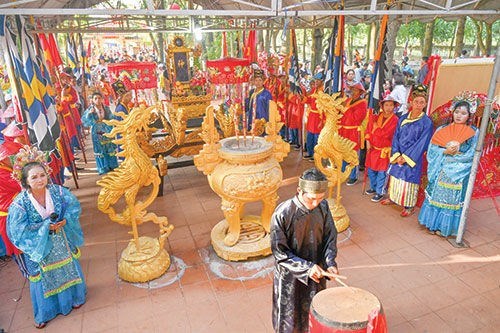Thay Thim Temple Festival named a national intangible cultural heritage
The recognition of the Thay Thim Temple Festival as part of national intangible cultural heritage is considered an important milestone in helping preserve traditional culture, boost tourism, and promote socio-economic development in Binh Thuan province.
 A palanquin procession of Thay Thim Temple Festival at the relic site in Tan Tien commune of La Gi town, Binh Thuan province (Photo: VNA)
A palanquin procession of Thay Thim Temple Festival at the relic site in Tan Tien commune of La Gi town, Binh Thuan province (Photo: VNA)The inclusion of this festival in the list is viewed as an important milestone helping boost local tourism and socio-economic development, improve the community’s awareness of cultural preservation, and diversify Vietnam’s cultural heritage.
Thay Thim Temple is about 12 kilometres to the northwest of La Gi town centre. It was recognised by the Ministry of Culture and Information (now the Ministry of Culture, Sports and Tourism) as a national historical and cultural relic site on September 27, 1997.
The festival, held in the town’s Tan Tien commune, is closely linked with local culture and traditional customs and has been upheld for more than 130 years.
“Thay Thim” (literally translated as Uncle and Aunt) is the way locals respectfully refer to a hermit and his wife, who were talented and kind-hearted people that helped the poor.
The legend of Thay (Chi Duc tien sinh) and Thim (Chi Duc nuong nuong Ton Than) is deeply imbued with educational values that promote humanity, morality, and a noble personality. It has been passed down from generation to generation. For residents, the couple symbolises kindness and compassion.
To pay tribute to Thay Thim, locals built a temple dedicated to them in the Bau Cai Forest, where they passed away, and chose the 15th day of the 9th lunar month to hold a commemoration of them.
 A ritual in Thay Thim Temple Festival (File photo: baobinhthuan.com.vn)
A ritual in Thay Thim Temple Festival (File photo: baobinhthuan.com.vn)It is a cultural and historical event that commemorates the merit and virtue of Thay Thim, who did noble deeds such as helping with boat building, giving medications to ill persons, and taming wild animals, winning the hearts of locals in the process.
The event features many traditional rituals, including “Nghinh Than” (Welcoming Gods) which invites Thay Thim’s spirits from their tombs about 7km away to come to the temple. Other rituals include “Thinh sac”, “Tinh sanh”, “Tuc yet”, and “Tien hien hau hien”.
Apart from solemn rituals, there are also many folk art performances like “cheo”, “tuong”, “ho”, and “ve” singing, along with folk games. The legend of Thay Thim is also retold through a play, while the sites associated with this legend are introduced in different forms at the festival.
From a small event, Thay Thim Temple Festival has become a major occurrence across the entire region, attracting participants from far and wide. It has long been viewed not only a unique traditional festival of the community but also as a common cultural heritage of many neighbouring localities in the southern region. It is a lively environment that preserves and promotes traditional culture, shows national cultural identity, and contributes to the diverse cultural heritage of Vietnam.
According to the Binh Thuan provincial Department of Culture, Sports and Tourism, the Thay Thim Temple Festival has become an attractive tourist destination. People come here not only on the occasion of the festival but also all year round.
In recent years, the number of visitors to Thay Thim Temple has been on the rise, about 600,000 each year./.










